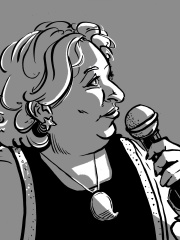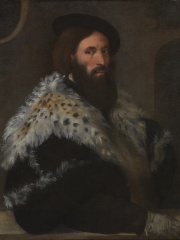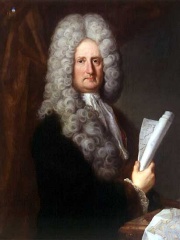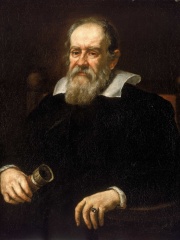

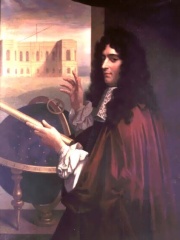
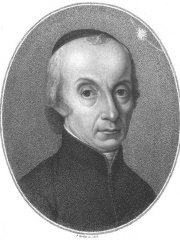
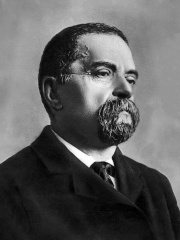
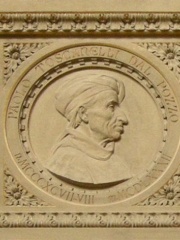
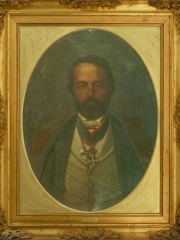
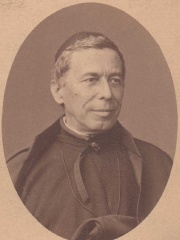
The Most Famous
ASTRONOMERS from Italy
This page contains a list of the greatest Italian Astronomers. The pantheon dataset contains 644 Astronomers, 31 of which were born in Italy. This makes Italy the birth place of the 5th most number of Astronomers behind United Kingdom, and France.
Top 10
The following people are considered by Pantheon to be the top 10 most legendary Italian Astronomers of all time. This list of famous Italian Astronomers is sorted by HPI (Historical Popularity Index), a metric that aggregates information on a biography's online popularity. Visit the rankings page to view the entire list of Italian Astronomers.

1. Galileo Galilei (1564 - 1642)
With an HPI of 95.08, Galileo Galilei is the most famous Italian Astronomer. His biography has been translated into 203 different languages on wikipedia.
Galileo di Vincenzo Bonaiuti de' Galilei (15 February 1564 – 8 January 1642), commonly referred to as Galileo Galilei ( GAL-il-AY-oh GAL-il-AY, US also GAL-il-EE-oh -, Italian: [ɡaliˈlɛːo ɡaliˈlɛi]) or mononymously as Galileo, was an Italian astronomer, physicist, and engineer, sometimes described as a polymath. He was born in the city of Pisa, then part of the Duchy of Florence. Galileo has been called the father of observational astronomy, modern-era classical physics, the scientific method, and modern science. Galileo studied speed and velocity, gravity and free fall, the principle of relativity, inertia, projectile motion, and also worked in applied science and technology, describing the properties of the pendulum and "hydrostatic balances". He was one of the earliest Renaissance developers of the thermoscope and the inventor of various military compasses. With an improved telescope he built, he observed the stars of the Milky Way, the phases of Venus, the four largest satellites of Jupiter, Saturn's rings, lunar craters, and sunspots. He also built an early microscope. Galileo's championing of Copernican heliocentrism was met with opposition from within the Catholic Church and from some astronomers. The matter was investigated by the Roman Inquisition in 1615, which concluded that his opinions contradicted accepted Biblical interpretations. Galileo later defended his views in Dialogue Concerning the Two Chief World Systems (1632), which appeared to attack and ridicule Pope Urban VIII, thus alienating both the Pope and the Jesuits, who had both strongly supported Galileo until this point. He was tried by the Inquisition, found "vehemently suspect of heresy", and forced to recant. He spent the rest of his life under house arrest. During this time, he wrote Two New Sciences (1638), primarily concerning kinematics and the strength of materials.

2. Giordano Bruno (1548 - 1600)
With an HPI of 88.57, Giordano Bruno is the 2nd most famous Italian Astronomer. His biography has been translated into 111 different languages.
Giordano Bruno ( jor-DAH-noh BROO-noh, Italian: [dʒorˈdaːno ˈbruːno]; Latin: Iordanus Brunus Nolanus; born Filippo Bruno; February 1548 – 17 February 1600) was an Italian philosopher, poet, alchemist, astronomer, cosmological theorist, and esotericist. He is known for his cosmological theories, which conceptually extended to include the then-novel Copernican model. He practised Hermeticism and gave a mystical stance to exploring the universe. He proposed that the stars were distant suns surrounded by their own planets (exoplanets), and he raised the possibility that these planets might foster life of their own, a cosmological position known as cosmic pluralism. He also insisted that the universe is infinite and could have no centre. Bruno was tried for heresy by the Roman Inquisition on charges of denial of several core Catholic doctrines, including eternal damnation, the Trinity, the deity of Christ, the virginity of Mary, and transubstantiation. Bruno's pantheism was not taken lightly by the church, nor was his teaching of metempsychosis regarding the reincarnation of the soul. The Inquisition found him guilty, and he was burned at the stake in Rome's Campo de' Fiori in 1600. After his death, he gained considerable fame, being particularly celebrated by 19th- and early 20th-century commentators who regarded him as a martyr for science. Some historians are of the opinion his heresy trial was not a response to his cosmological views but rather a response to his religious and afterlife views, while others find the main reason for Bruno's death was indeed his cosmological views. Bruno's case is still considered a landmark in the history of free thought and the emerging sciences. In addition to cosmology, Bruno also wrote extensively on the art of memory, a loosely organised group of mnemonic techniques and principles. Historian Frances Yates argues that Bruno was deeply influenced by the presocratic Empedocles, Neoplatonism, Renaissance Hermeticism, and Book of Genesis–like legends surrounding the Hellenistic conception of Hermes Trismegistus. Other studies of Bruno have focused on his qualitative approach to mathematics and his application of the spatial concepts of geometry to language.

3. Giovanni Domenico Cassini (1625 - 1712)
With an HPI of 78.44, Giovanni Domenico Cassini is the 3rd most famous Italian Astronomer. His biography has been translated into 70 different languages.
Giovanni Domenico Cassini (8 June 1625 – 14 September 1712) was an Italian-French mathematician, astronomer, astrologer and engineer. Cassini was born in Perinaldo, near Imperia, at that time in the County of Nice, part of the Savoyard state. He discovered four satellites of Saturn and noted the division of its rings, later named the Cassini Division. Cassini was also the first of his family to begin work on the project of creating a topographic map of France. In addition, he also created the first scientific map of the Moon. The Cassini space probe, launched in 1997, was named after him and became the fourth to visit Saturn and the first to orbit it.

4. Giuseppe Piazzi (1746 - 1826)
With an HPI of 74.97, Giuseppe Piazzi is the 4th most famous Italian Astronomer. His biography has been translated into 72 different languages.
Giuseppe Piazzi (US: PYAHT-see; Italian: [dʒuˈzɛppe ˈpjattsi]; 16 July 1746 – 22 July 1826) was an Italian Catholic priest of the Theatine order, mathematician, and astronomer. He established an observatory at Palermo, now the Osservatorio Astronomico di Palermo – Giuseppe S. Vaiana. He is perhaps most famous for his discovery of the first dwarf planet, Ceres.
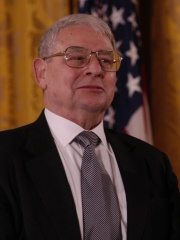
5. Riccardo Giacconi (1931 - 2018)
With an HPI of 74.70, Riccardo Giacconi is the 5th most famous Italian Astronomer. His biography has been translated into 76 different languages.
Riccardo Giacconi ( jə-KOH-nee, Italian: [rikˈkardo dʒakˈkoːni]; October 6, 1931 – December 9, 2018) was an Italian-American Nobel Prize-winning astrophysicist who laid down the foundations of X-ray astronomy. He was a professor at the Johns Hopkins University.

6. Giovanni Schiaparelli (1835 - 1910)
With an HPI of 74.56, Giovanni Schiaparelli is the 6th most famous Italian Astronomer. His biography has been translated into 56 different languages.
Giovanni Virginio Schiaparelli ( SKAP-ə-REL-ee, SHAP-, US also skee-AHP-, Italian: [dʒoˈvanni virˈdʒiːnjo skjapaˈrɛlli]; 14 March 1835 – 4 July 1910) was an Italian astronomer and science historian. Schiaparelli established the Martian system of nomenclature still in use today; before him, features of the planet bore the names of contemporary astronomers, similar to the lunar map of van Langren that preceded that of Hevelius.

7. Paolo dal Pozzo Toscanelli (1397 - 1482)
With an HPI of 71.41, Paolo dal Pozzo Toscanelli is the 7th most famous Italian Astronomer. His biography has been translated into 29 different languages.
Paolo dal Pozzo Toscanelli (1397 – 10 May 1482) was an Italian mathematician, astronomer, and cosmographer. Born in Florence, he was a notable local Renaissance figure. Christopher Columbus carried his map (depicting Asia to the west of Europe) on his first voyage to the New World.

8. Annibale de Gasparis (1819 - 1892)
With an HPI of 70.60, Annibale de Gasparis is the 8th most famous Italian Astronomer. His biography has been translated into 40 different languages.
Annibale de Gasparis (Italian pronunciation: [anˈniːbale de ˈɡasparis]; 9 November 1819 – 21 March 1892) was an Italian astronomer, known for discovering asteroids and his contributions to theoretical astronomy.

9. Angelo Secchi (1818 - 1878)
With an HPI of 68.77, Angelo Secchi is the 9th most famous Italian Astronomer. His biography has been translated into 39 different languages.
Angelo Secchi (Italian pronunciation: [ˈandʒelo ˈsekki]; 28 June 1818 – 26 February 1878) was an Italian Catholic priest and astronomer from the Italian region of Emilia. He was director of the observatory at the Pontifical Gregorian University (then called the Roman College) for 28 years. He was a pioneer in astronomical spectroscopy, and was one of the first scientists to state authoritatively that the Sun is a star.
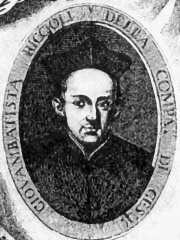
10. Giovanni Battista Riccioli (1598 - 1671)
With an HPI of 68.60, Giovanni Battista Riccioli is the 10th most famous Italian Astronomer. His biography has been translated into 38 different languages.
Giovanni Battista Riccioli (17 April 1598 – 25 June 1671) was an Italian astronomer and a Catholic priest in the Jesuit order. He is known, among other things, for his experiments with pendulums and with falling bodies, for his discussion of 126 arguments concerning the motion of the Earth, and for introducing the current scheme of lunar nomenclature. He is also widely known for discovering the first double star. He argued that the rotation of the Earth should reveal itself because on a rotating Earth, the ground moves at different speeds at different times. The asteroid 122632 Riccioli is named after him.
People
Pantheon has 31 people classified as Italian astronomers born between 1210 and 1969. Of these 31, 4 (12.90%) of them are still alive today. The most famous living Italian astronomers include Luciano Tesi, Maura Tombelli, and Stefano Sposetti. The most famous deceased Italian astronomers include Galileo Galilei, Giordano Bruno, and Giovanni Domenico Cassini.
Living Italian Astronomers
Go to all RankingsLuciano Tesi
1931 - Present
HPI: 55.73
Maura Tombelli
1952 - Present
HPI: 52.69
Stefano Sposetti
1958 - Present
HPI: 48.59
Andrea Boattini
1969 - Present
HPI: 47.39
Deceased Italian Astronomers
Go to all RankingsGalileo Galilei
1564 - 1642
HPI: 95.08
Giordano Bruno
1548 - 1600
HPI: 88.57
Giovanni Domenico Cassini
1625 - 1712
HPI: 78.44
Giuseppe Piazzi
1746 - 1826
HPI: 74.97
Riccardo Giacconi
1931 - 2018
HPI: 74.70
Giovanni Schiaparelli
1835 - 1910
HPI: 74.56
Paolo dal Pozzo Toscanelli
1397 - 1482
HPI: 71.41
Annibale de Gasparis
1819 - 1892
HPI: 70.60
Angelo Secchi
1818 - 1878
HPI: 68.77
Giovanni Battista Riccioli
1598 - 1671
HPI: 68.60
Girolamo Fracastoro
1476 - 1553
HPI: 67.22
Luigi Ferdinando Marsili
1658 - 1730
HPI: 64.36
Overlapping Lives
Which Astronomers were alive at the same time? This visualization shows the lifespans of the 16 most globally memorable Astronomers since 1700.


